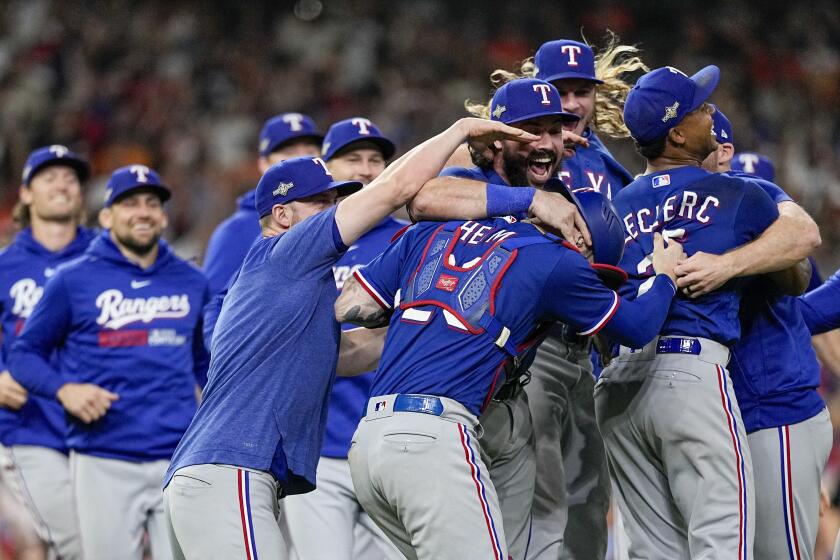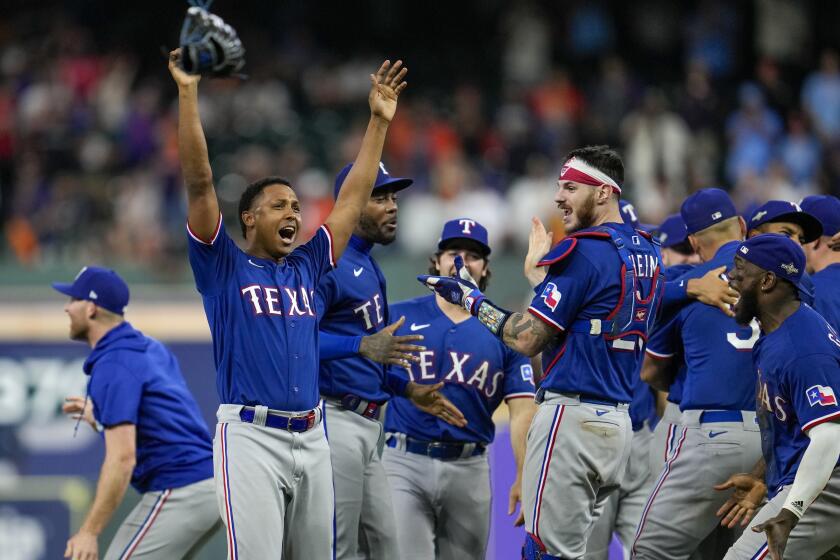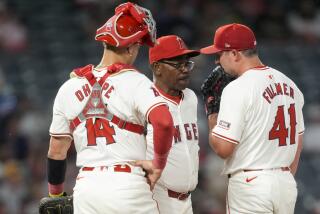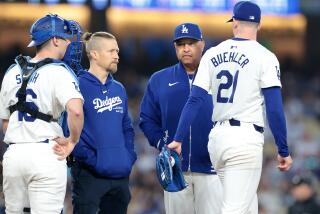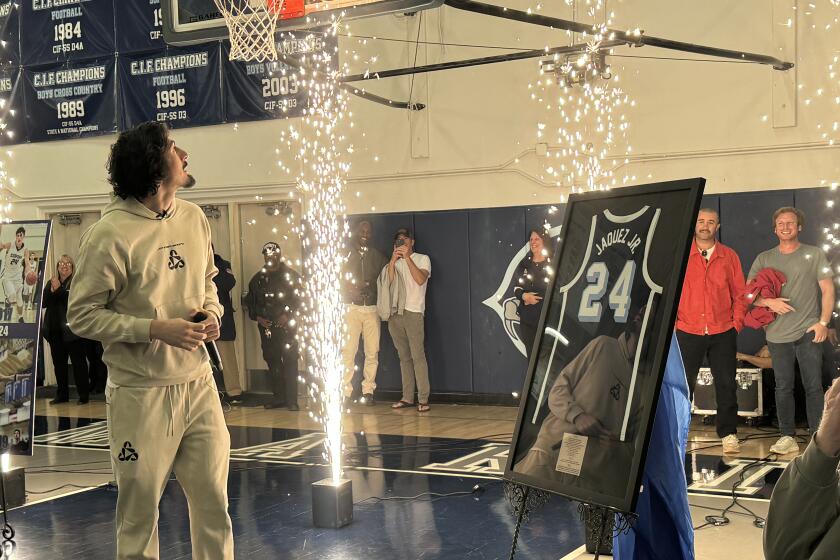‘He’s the same Corey Seager.’ Former Dodgers shortstop fuels Rangers’ World Series run
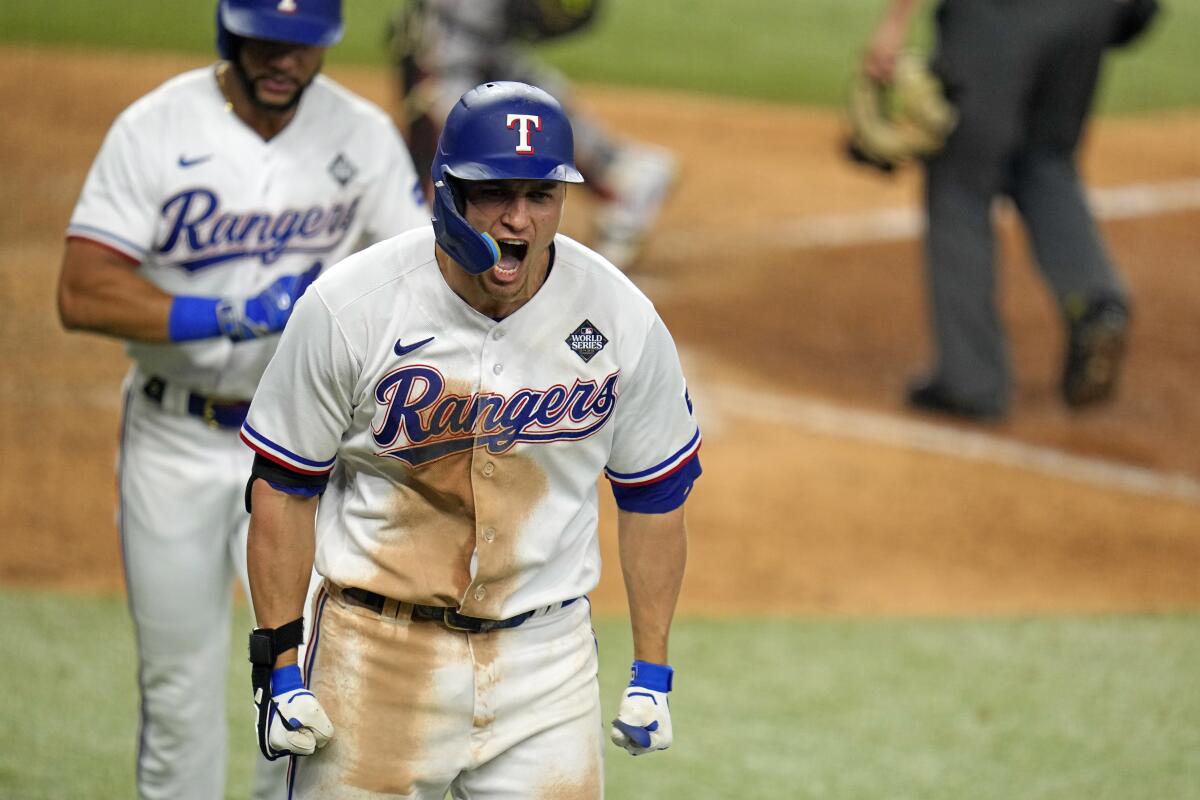
ARLINGTON, Texas — Max Scherzer thought the answer was obvious. Corey Seager — the quiet, maniacal hitting savant — changing? Seriously?
“No, he’s the same Corey Seager,” Scherzer said with a grin. “Did you ever think he would change? No.”
Scherzer then erupted in laughter. He’s been Seager’s teammate for two half-seasons — in 2021 with the Dodgers and this year with the Texas Rangers. In between, Seager signed one of the richest contracts in North American sports history, leaving one of baseball’s marquee franchises to become the face of a resurgent team while cementing his place as one of the best hitters in the majors. All that change theoretically could change a person, even just a little bit. But not Seager.
Across the way from Scherzer, between sections 107 and 108 along the third base line at Globe Life Field, Seager’s demeanor during World Series media day Thursday suggested nothing’s changed. The shortstop was indifferent with reporters. His answers to questions about himself weren’t expansive. He seemed almost uncomfortable with the attention. He was asked about rarely showing emotion on the field either.
The Texas Rangers are back in the World Series for the first time since 2011, with former Dodgers star Corey Seager being a key piece.
“It’s just kind of my personality,” Seager said.
His on-field production also hasn’t changed. Three years after leading the Dodgers to the 2020 title in the Texas bubble with NLCS and World Series MVP performances, Seager returned to that stage on the same field with the home team against the Arizona Diamondbacks for Game 1 of the World Series on Friday. And he continued mashing at Globe Life Field under the brightest lights.
With the Rangers facing a two-run deficit with one out in the ninth inning, Seager jumped on a first-pitch, 94-mph fastball from Diamondbacks closer Paul Sewald and launched it for a tying home run. Two innings later, Adolis García, the ALCS MVP, delivered a walk-off home run to give the Rangers a 6-5 comeback win.
Seager’s blast was his 17th career postseason home run — behind only Derek Jeter and Carlos Correa for most by a shortstop in Major League Baseball history. He’s hit 10 of them at Globe Life Field; just six other players have that many playoff home runs at one venue. His instant reaction to No. 10 — a roar as the ball traveled through the air — was identical to the one he mustered when he clubbed a go-ahead home run off Justin Verlander in Game 2 of the 2017 World Series. His postseason résumé dwarfs most of his contemporaries.
“Big-time players do big-time things in big-time moments,” Diamondbacks manager Torey Lovullo said after his club’s crushing defeat.

Earlier this month, days after the Diamondbacks swept the Dodgers in the NLDS for another shocking early playoff exit, Dodgers president of baseball operations Andrew Friedman offered a different take on Seager’s ability to step up in October. When asked if teams could be specifically built for postseason success, Friedman, unsolicited, brought up Seager.
“We’ve had guys who’ve been incredible one year, not good the next, mediocre one year,” Friedman said. “It’s not just like, ‘Oh, he is a postseason player, he is not.’ It’s just not that simple. And we’ve seen it firsthand. I mean, look at Corey Seager’s 2019, 2020, 2021. I mean, there are so many examples of guys that, it’s just not that easy to be like, ‘Oh, let’s just get the guy who’s going to perform in October.’ Because if it was, I promise you we would do that.”
Seager went 3 for 20 (.150) with one double in five playoff games in 2019. The next year, he orchestrated the most productive postseason in Dodgers history, batting .328 with eight home runs and a 1.171 OPS in 18 games to help win the Dodgers’ first World Series in 32 years. More struggles followed in his final 12 games as a Dodger in 2021. He finished that postseason 9 for 48 (.188) with two home runs and a .639 OPS.
This year, he’s reverted to his 2020 postseason form. In 13 games, he’s batting .327 with four home runs, five doubles, 14 walks to eight strikeouts, and a 1.157 OPS.
And for the first time, it’s with the Rangers, the team that decided to build around him. He is the best player on a team vying for the franchise’s first championship, coming off a regular season in which he’d be the front-runner for American League MVP if not for Shohei Ohtani’s two-way prowess.
In Los Angeles, Seager was one of several stars. In 2021, Seager’s last year with the organization that drafted him in the first round in 2012, the Dodgers boasted at least four future Hall of Famers (Scherzer, Clayton Kershaw, Mookie Betts, Albert Pujols) plus several other household names.
Seager was coming off his historic postseason run, joining Orel Hershiser as the only Dodgers to win both NLCS and World Series MVP in the same postseason. He was a rookie of the year, a two-time All-Star and finished in the top 10 in NL MVP voting twice with the Dodgers. He was just 27 when he reached free agency.
But the Dodgers knew he likely wouldn’t return once he turned down an eight-year, $250 million contract extension during spring training in 2021. They then acquired Trea Turner with Scherzer in July anticipating Turner would replace Seager at shortstop when he left that winter. The Dodgers were interested in a reunion, but not in matching a 10-year, $325 million contract. His defense at shortstop was average, at best, and he had dealt with several injuries during his seven-plus seasons in Los Angeles. They chose to allocate their money elsewhere.
In his second season in Texas, former Dodgers shortstop Corey Seager has helped propel the Rangers to first place in the American League West.
Three years later, Seager isn’t just one of the guys. He’s the guy. The Rangers spent $800 million over the last two offseasons to resurrect a franchise two years removed from a 102-loss campaign. Texas committed nearly half of the binge to Seager. Other notable veterans such as Marcus Semien and Jacob deGrom got paid too, but Seager is the metronomic centerpiece still obsessing over his swing and still producing clutch hits.
“He’s the exact same,” said Rangers reliever Josh Sborz, who spent parts of two seasons with Seager on the Dodgers. “Great guy, good leader, works hard. He’s always there. Just a good dude, man, overall, and it’s one of the reasons why he’s special.”
This season, Seager landed on the injured list twice with hamstring and thumb injuries, but batted a career-best .327 with a career-high-tying 33 home runs and a career-high 1.013 OPS in 119 games while making his fourth All-Star team.
The Rangers finished tied with the Houston Astros at 90 wins, but lost the tiebreaker, relegating them to a wild card and a matchup with the 99-win Tampa Bay Rays. They promptly swept the Rays in a three-game series and the Baltimore Orioles in the best-of-five division series.
Seager went seven for 14 with a home run, three doubles, 11 walks, just one strikeout and a 1.649 OPS in the five wins. The success didn’t continue through the first six games of the ALCS against the Astros. He was five for 27 (.192) with five strikeouts and no walks going into Game 7 in Houston.
Then, in his first at-bat of the win-or-go-home game, Seager blasted a 440-foot solo home run to begin the Rangers’ 11-4 rout. He finished three for five with a walk. He saved his best for when it was needed most to help send the Rangers to the World Series for the first time since 2011.
Adolis García homers twice as the Texas Rangers advance to the World Series with an 11-4 win over the Houston Astros in Game 7 of the ALCS.
“That’s as much emotion as [he’s shown],” manager Bruce Bochy said of Seager’s celebration after crossing home plate. “He does show emotion, but he really showed it when he came in. He fired up the whole club.”
More of that rare emotion was on display late Friday the second Seager connected on Sewald’s mistake. He erupted. More than 40,000 people around him erupted. Different uniform, bigger paychecks, same Corey Seager.
More to Read
Go beyond the scoreboard
Get the latest on L.A.'s teams in the daily Sports Report newsletter.
You may occasionally receive promotional content from the Los Angeles Times.

